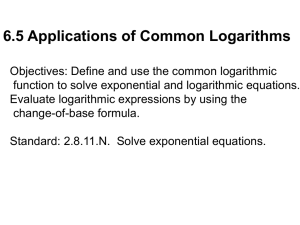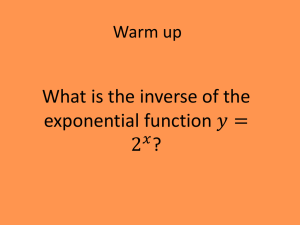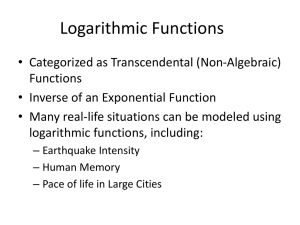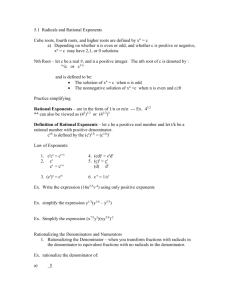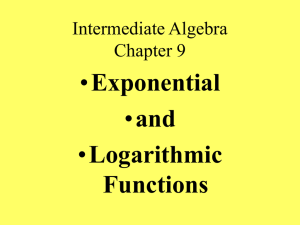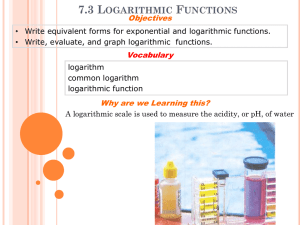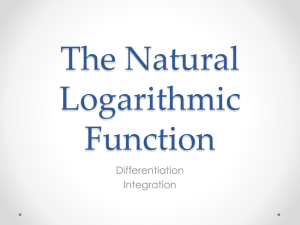Logarithmic Functions: Common & Natural Logs Explained
advertisement
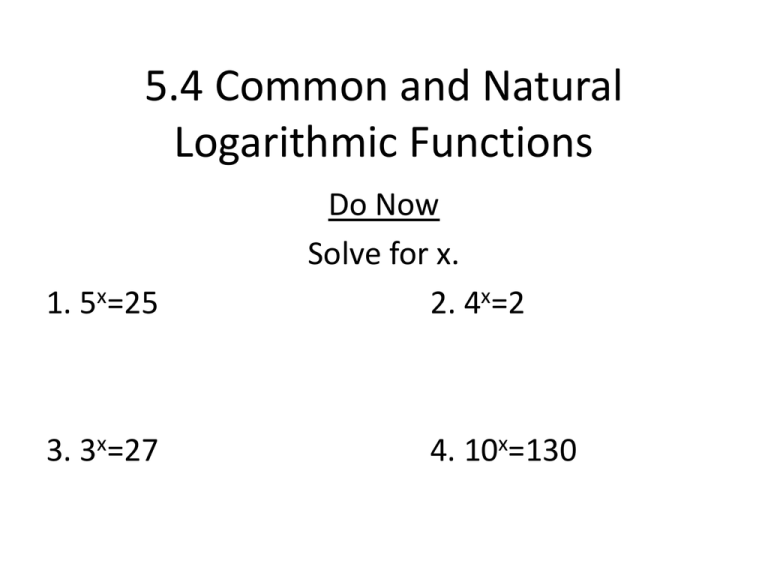
5.4 Common and Natural Logarithmic Functions 1. 5x=25 3. 3x=27 Do Now Solve for x. 2. 4x=2 4. 10x=130 5.4 Common and Natural Logarithmic Functions 1. 5x=25 x=2 3. 3x=27 x=3 Do Now Solve for x. 2. 4x=2 x= ½ 4. 10x=130 x≈2.11 Common Logarithms • The inverse function of the exponential function f(x)=10x is called the common logarithmic function. – Notice that the base is 10 – this is specific to the “common” log • The value of the logarithmic function at the number x is denoted as f(x)=log x. • The functions f(x)=10x and g(x)=log x are inverse functions. • log v = u if and only if 10u = v – Notice that the base is “understood “to be 10. • Because exponentials and logarithms are inverses of one another, what do we know about their graphs? Common Logarithms • Since logs are a special kind of exponent, each logarithmic statement can be expressed as an exponential. Logarithmic Exponential log 29 = 1.4624 101.4624 = 29 log 378 = 2.5775 102.5775 = 378 Example 1: Evaluating Common Logs • Without using a calculator, find each value. 1. log 1000 2. log 1 3. log 10 4. log (-3) Example 1: Solutions • Without using a calculator, find each value 1. log 1000 10x = 1000 log 1000 = 3 2. log 1 10x = 1 log 1 = 0 3. log 10 10x = 10 log 10 = 1/2 4. log (-3) 10x = -3 undefined Evaluating Logarithms • A calculator is necessary to evaluate most logs, but you can get a rough estimate mentally. • For example, because log 795 is greater than log 100 = 2 and less than log 1000 = 3, you can estimate that log 795 is between 2 and 3, and closer to 3. Using Equivalent Statements • A method for solving logarithmic or exponential equations is to use equivalent exponential or logarithmic statements. • For example: – To solve for x in log x = 2, we can use 102 = x and see that x = 100 – To solve for x in 10x = 29, we can use log 29 = x, and using a calculator to evaluate shows that x = 1.4624 Example 2: Using Equivalent Statements • Solve each equation by using an equivalent statement. 1. log x = 5 2. 10x = 52 Example 2: Solution • Solve each equation by using an equivalent statement. 1. log x = 5 105 = x 2. 10x = 52 log 52 = x x = 100,000 x ≈ 1.7160 Natural Logarithms • The exponential function f(x)=ex is useful in science and engineering. Consequently, another type of logarithm exists, where the base is e instead of 10. • The inverse function of the exponential function f(x)=ex is called the natural logarithmic function. • The value of this function at the number x is denoted as f(x)=ln x and is called the natural logarithm. Natural Logarithms • The functions f(x)=ex and g(x)=ln x are inverse functions. • ln v = u if and only if eu = v • Notice that the base is “understood” to be e. • Again, as with common logs, every natural logarithmic statement is equivalent to an exponential statement. Logarithmic Exponential ln 14 = 2.6391 e2.6391 = 14 ln 0.2 = -1.6094 e-1.6094 = 0.2 Example 3: Evaluating Natural Logs • Use a calculator to find each value 1. ln 1.3 2. ln 203 3. ln (-12) Example 3: Solutions • Use a calculator to find each value 1. ln 1.3 .2624 2. ln 203 5.3132 3. ln (-12) undefined Why is this undefined?? Example 4: Solving by Using and Equivalent Statement • Solve each equation by using an equivalent statement. 1. ln x = 2 2. ex = 8 Example 4: Solutions • Solve each equation by using an equivalent statement. 1. ln x = 2 e2 = x 2. ex = 8 ln8 = x x = 7.3891 x = 2.0794 Graphs of Logarithmic Functions • The following table compares graphs of exponential and logarithmic functions (page 359 in your text): Exponential Functions Logarithmic Functions Examples f(x) = 10x; f(x) = ex g(x) = log x; g(x) = ln x Domain All real numbers All positive real numbers Range All positive real numbers All real numbers f(x) increases as x increases g(x) increases as x increases f(x) approaches the xaxis as x-decreases g(x) approaches the yaxis as x approaches 0 (0, 1) (1, 0) Reference Point Example 5: Transforming Logarithmic Functions • Describe the transformation of the graph for each logarithmic function. Identify the domain and range. 1. 3log(x+4) 2. ln(2-x)-3 Example 5: Transforming Logarithmic Functions • Describe the transformation of the graph for each logarithmic function. Identify the domain and range. 1. 3log(x+4) Shifted to the left 4 units; vertically stretched by 3 Domain: x > -4 Range: All real numbers 2. ln(2-x)-3 = ln(-(x-2))-3 Horizontal reflection across y-axis; 2 units to the right; 3 units down Domain: x > 2 Range: All real numbers


